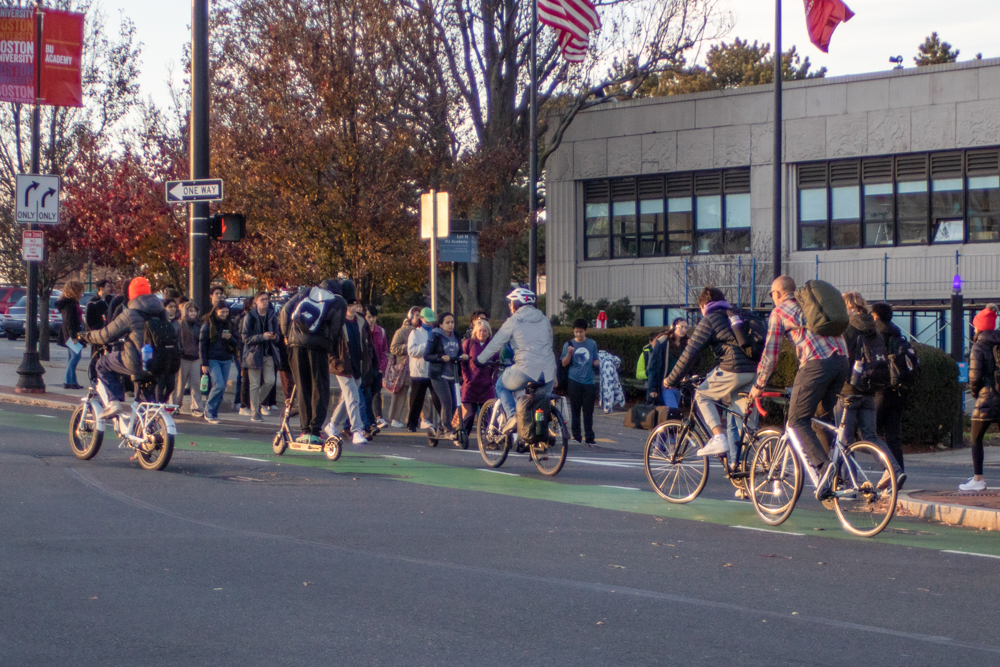Boston has so far failed to address concerns over cycling and pedestrian infrastructure after Samuel Alvarado, a 21-year-old man, was killed while riding his bike at the intersection of Hano and Cambridge St. in Allston last December, according to the Allston-Brighton Health Collaborative.

The Boston Cyclists Union, the Allston-Brighton Health Collaborative, LivableStreets Alliance and the Massachusetts Bicycle Coalition, commonly known as MassBikes, released a joint statement on the same day as Samuel’s accident.
“Safety improvements for this area are long overdue … Samuel should be alive today,” the statement said.
Hano and Cambridge St. is one block north of Union Square, part of a three-block-long stretch of Cambridge St. around Union Square that lacks painted-only bike lanes, unlike the rest of Cambridge St. through Allston.
Anna Leslie, director of the ABHC, said the commission hosted a mobility audit of the intersection where Alvarado was killed on Jan. 27.
“The biggest thing about that section of Cambridge St. is it’s a really big thoroughfare near an exit to I-90 [and] a lot of heavy trucks go down that street … it’s a very busy road at all hours of the day, and there is no protected bike lane infrastructure,” Leslie said.
Alvarado’s tragedy is not the first time improved safety has been called for in the area. In 2022, the city of Boston and the Mass. Department of Transportation made safety improvements on Cambridge St, but residents have continued to call for safer bike lanes in the neighborhood since.
Leslie said that the amount of cars and “curb cuts” in the sidewalks lead many pedestrians to walk on the road, raising concern for pedestrian safety as well. Another flaw found by the audit was that Hano and Cambridge St. needs “daylighting,” indicating the need for enough space so oncoming traffic can see pedestrians.
In light of Alvarado’s death, a Streets Cabinet spokesperson wrote in an email that the tragedy “reflects the need to continue building safer streets and separated bike lanes as this infrastructure makes streets safer for all street users.”
“We have set a goal of expanding the bike network so that 50 percent of residents will be a 3-minute walk from a safe and connected bike route,” The Streets Cabinet spokesperson wrote. “In 2023, ten miles of protected bike lanes were built throughout the network.”
According to the email, protected bike infrastructure is currently in design for North Beacon Street, Western Avenue and Winship Street within the Allston-Brighton neighborhood. The proposed Route 57 Bus Priority project would include a shared bus and bike lane along Cambridge Street between Union Square and Brighton Center, according to the email from the Street Cabinet.
The Brighton Center is on the opposite side of Union Square from where Samuel was killed, Streets Cabinet did not mention renovations to Hano and Cambridge St.
ABHC conducted another mobility audit on the area around Union Square in October 2022 identifying the same need for daylighting at Hano and Cambridge St. as well as the need for a stop sign. ABHC presented the findings of that audit to the Boston Transportation Department in December 2022 and again in April 2023 after another pedestrian was injured on Cambridge St. on the other side of Union Square — according to the commission, the city failed to heed either of these warnings.
“The inaction from the city is concerning, especially when there are known dangers that have been pointed out by residents and advocates who know these streets,” said Galen Mook, Executive Director of MassBikes.
Mook said that he thinks the city of Boston is doing a lot, especially when the Transportation Department has “the directive and it’s prioritized.” But he has noticed a lack of that direction in Allston-Brighton.
“Not so much in Allston-Brighton, but we have seen them move, so I wouldn’t say they’re incapable of action,” Mook said. “I think [the] challenge is where they’re prioritizing their resources, and sometimes the neighborhoods that — I hate to say this — have the loudest voices or most powerful residents get a little bit more attention.”
At Hano and Cambridge St., ABHC’s audits’ findings about large vehicles are seen as 18-wheelers coming off the Mass Pike drive past multiple times a minute.
John Bailes is a Somerville resident who walks about nine miles a day and says that the area around Cambridge St. is one of the least safe he frequents.
“[Cambridge St.] is pretty dangerous, a lot of traffic and people don’t pay attention to pedestrians and bicycles so well,” Bailes said. “They don’t yield and can be aggressive.”
Bailes said that in Somerville, “they’re painting everything for protection for pedestrians and cyclists, so I’m all with that.”
Josh Ferris bikes along Cambridge St. almost every day and lives near to where Alvarado was killed.
“A lot of cars are not really looking for cyclists,” Ferris said. “It’s easy to blame them because when there’s no infrastructure present, and everything’s suited around cars, it makes sense.”
CORRECTION: A previous version of this article called the Allston-Brighton Health Collaborative the Allston-Brighton Health Commission. The updated article reflects this change.
CORRECTION: A previous version of this article misspelled Alvarado’s name. The updated article reflects this change.























































































































anonymous • Feb 2, 2024 at 2:31 pm
Great article. I live in Allston and the saw the ambulances by Walgreens when this happened. Legislation to support bikers/walkers/runners is absolutely needed moving forward.